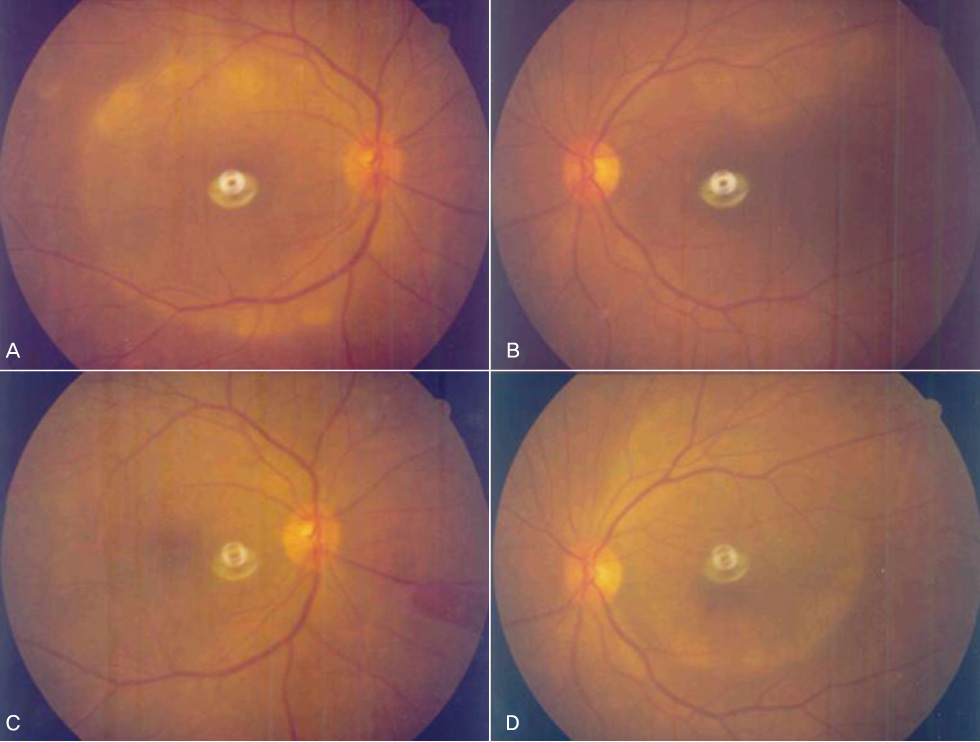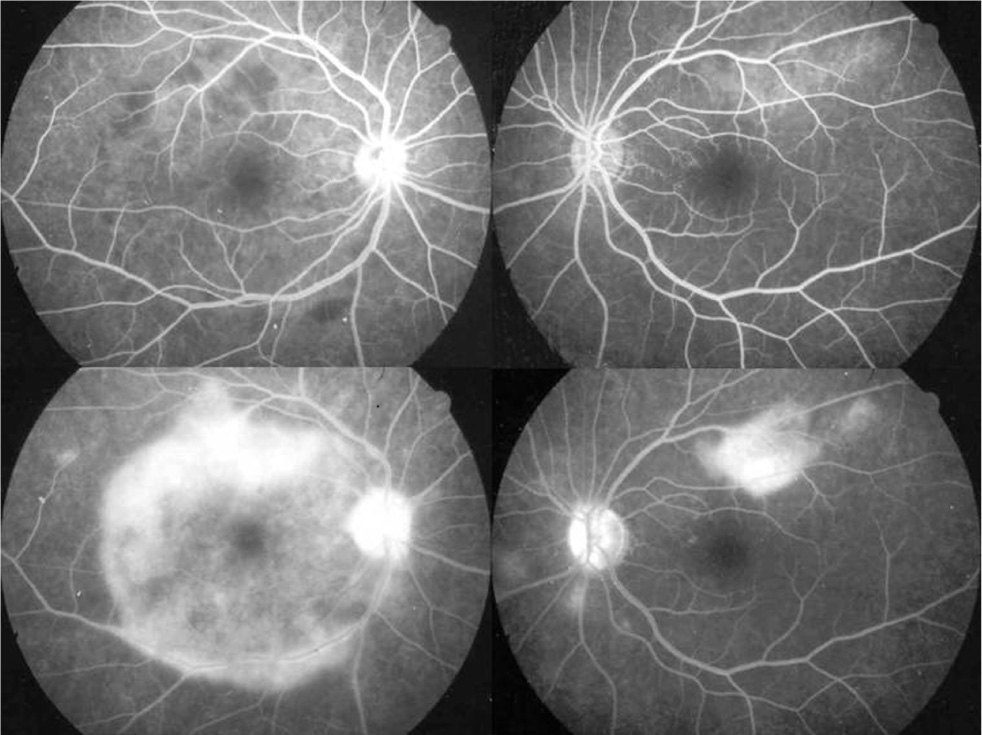Korean J Ophthalmol.
2009 Jun;23(2):108-111. 10.3341/kjo.2009.23.2.108.
Atypical Acute Syphilitic Posterior Placoid Chorioretinitis
- Affiliations
-
- 1Department of Ophthalmology, Korea University College of Medicine, Seoul, Korea. ojr4991@yahoo.co.kr
- KMID: 754727
- DOI: http://doi.org/10.3341/kjo.2009.23.2.108
Abstract
- A 48-year-old man presented with visual dimness in the right eye that had developed 2 weeks previously. Dilated fundus examination showed few vitreous cells and numerous yellow, placoid lesions in both eyes. His right eye had more severe serous retinal detachment involving the macula. Fluorescein angiography demonstrated early irregular hypofluorescence with late staining in the areas of the yellow placoid lesions. He started a regimen of 60 mg of oral prednisone daily. Two weeks later, a serologic fluorescent treponemal antigen absorption test was positive for Ig G and Ig M. He was referred to an infectious disease specialist for antibiotic therapy. A week later, he returned, having stayed on prednisone only and not having taken the internist's antibiotic prescription. Meanwhile, the chorioretinitis in his right eye, which had initially been at a more advanced stage, was resolved with the use of steroids. The chorioretinitis in his left eye, which was aggravated at an earlier stage, ultimately recovered. Our case had atypical courses such that one eye improved and the other worsened during the same steroid treatment period. This result was inconsistent with that of previous reports showing that oral steroid influences the clinical course of acute syphilitic posterior placoid chorioretinitis.
MeSH Terms
-
Acute Disease
Anti-Bacterial Agents/administration & dosage
Ceftriaxone/administration & dosage
Chorioretinitis/diagnosis/drug therapy/*microbiology
Diagnosis, Differential
Eye Infections, Bacterial/diagnosis/drug therapy/*microbiology
Fluorescein Angiography
Follow-Up Studies
Fundus Oculi
Humans
Injections, Intravenous
Male
Middle Aged
Syphilis/diagnosis/drug therapy/*microbiology
Figure
Cited by 2 articles
-
Clinical Course Following Intravitreal Bevacizumab Injection in Posterior Placoid Chorioretinitis
Se Hoon Han, Ji Won Lim
J Korean Ophthalmol Soc. 2013;54(5):829-833. doi: 10.3341/jkos.2013.54.5.829.Ocular Syphilis Presented as Occult Outer Retinopathy
Sung Who Park, Jong Ho Park, Ik Soo Byon, Ji Eun Lee
J Korean Ophthalmol Soc. 2014;55(5):785-788. doi: 10.3341/jkos.2014.55.5.785.
Reference
-
1. Gass JD, Branunstein RA, Chenoweth RG. Acute syphilitic posterior placoid chorioretinitis. Ophthalmology. 1990. 97:1288–1297.2. Zamani M, Garfinkel RA. Corticosteroid-induced modulation of acute syphilitic posterior placoid chorioretinitis. Am J Ophthalmol. 2003. 135:891–894.3. Samson CM, Foster CS. Foster CS, Vitale AT, editors. Syphilis. Diagnosis and Treatment of Uveitis. 2001. Philadelphia: WB Saunders;237–243. chap.15.4. Tran TH, Cassoux N, Bodaghi B, et al. Syphilitic uveitis in patients infected with human immunodeficiency virus. Graefes Arch Clin Exp Ophthalmol. 2005. 243:863–869.5. Erol N, Topbas S. Acute syphilitic posterior placoid chorioretinitis after an intravitreal triamcinolone acetonide injection. Acta Ophthalmol Scand. 2006. 84:435.
- Full Text Links
- Actions
-
Cited
- CITED
-
- Close
- Share
- Similar articles
-
- Relentless Placoid Chorioretinitis in a Young Man
- Clinical Course Following Intravitreal Bevacizumab Injection in Posterior Placoid Chorioretinitis
- A Case of Acute Posterior Multifocal Placoid Pigment Epitheliopathy, Associated with Bilateral Serous Retinal Detachment
- A Case of Acute Posterior Multlfocal Placoid Pigment Epithellopathy
- A Case of Acute Posterior Multifocal Placoid Pigment Epitheliopathy



